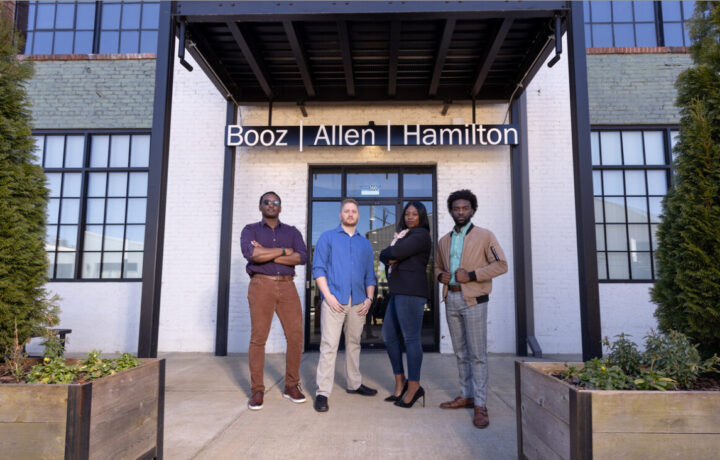Booz Allen helped NASA with the theoretical trajectory that put the first man on the Moon. More than 50 years later, they’re working on space systems to get the first woman on the Moon—and open the path to Mars. Read an interview with NASA’s chief historian, Bill Barry, on how Apollo 11 enabled current space missions and about Booz Allen’s ongoing partnership to create the future today.
Setting the Course
“The decision to go with lunar orbit rendezvous (LOR) was critical to get to the Moon in a decade,” says Barry. In the early days of Apollo program planning, NASA’s internal teams were divided on which strategy, or mission mode, to use. Direct ascent, for example, would require a giant Saturn rocket with enough power to propel astronauts to the lunar surface. In addition to conducting its own studies, NASA turned to a few trusted consultants for preliminary calculations. One partner was Booz Allen, who had been an advisor since helping pioneering rocket scientist Wernher von Braun justify funding to begin U.S. space exploration.
An early Booz Allen leader, Bill Pocock, recounted the recommendation of LOR, the winning option: “Fire out of the earth orbit into the moon orbit, inject yourself into the moon orbit, drop a lander, and come up back through the same series … that was the way to do it.”
Barry says NASA ended up choosing LOR for a simple reason: “The math won out.” Although it was considered riskier, analysis showed LOR was the only option that could meet President John F. Kennedy’s mandate to reach the Moon before the end of the decade. It was a successful solution: Apollo 11 launched on July 16, 1969, landed on the moon July 20, and returned safely to Earth 4 days later.
The mission demonstrated America’s vision and inspired the world. “After the mission, Neil Armstrong and Buzz Aldrin toured more than 100 countries,” says Bill. “They were amazed at how engaged people were. People wouldn’t say, ‘You landed on the Moon.’ They’d say, ‘We landed on the Moon.”
He noted that Apollo brought scientists together around the world and improved culture through advancing business technology. “SpaceX and other commercial vehicles are not such a new idea. NASA has always tapped into the ingenuity of our commercial partners—like Booz Allen,” he said.
Moving the Mission
More than 50 years later, NASA is building on knowledge gained from Apollo for its Artemis Moon mission, working with commercial and international partners on space systems to lay the foundation for eventual human exploration of Mars. The International Space Station plays an important role. “We’re using it to test-drive the technology we’ll need to go beyond,” Barry says. “How well does a system work? Will we need to 3D-print spare parts? Do we have a way to recycle resources and grow plants? We want to close the usage loop as much as possible.”
Booz Allen has worked on the International Space Station since the beginning:
- The company was part of the initial Space Operations Task Force that helped shape the original vision.
- They’ve provided complex systems engineering and integration (SE&I) work encompassing major program changes, 11 years of on-orbit assembly, and current science and research operations.
- When the complex, multi-contract program ran into cost challenges, their cross-functional team reengineered the initiative, setting it back on track and providing $500 million in budget savings.
- Today, their engineers handle logistics and operations, from conducting analyses of onboard systems for operations planning to coordinating logistics traffic from vehicles—whether from commercial partners like SpaceX and Northrop Grumman or international traffic from Russia and Japan.
It’s the most complex engineering program of all time, and Booz Allen helps keep it one of the most successful. Learn more about their decades of ISS support.
The Path to Mars
NASA is planning to lead an international partnership to lay the foundation for exploring Mars and beyond. The firm is using all its ou capabilities—engineering, consulting, analytics, digital solutions, and cyber—to help prepare mission-essential elements. Over the years they’ve developed services at the forefront of exploration and space defense. For the Artemis program, they’re providing:
- Ground systems engineering support for the Space Launch System (SLS) rocket and the Orion spacecraft
- Hardware and software systems integration for the Orion program, a spacecraft for cislunar (Earth to Moon) voyages which will launch atop the SLS
- SE&I support, including digital modernization, for Gateway, the international lunar-orbit platform which will provide a staging ground for deep space missions, as well as the lunar lander that will ferry astronauts from the Gateway to the lunar surface
- Data analysis and visualization to analyze trajectory data to determine the best launch date
- Strategic consulting and cybersecurity services to support Exploration Systems Development
See more ways Booz Allen is helping create the future of space and search aerospace careers.
Join us. The world can’t wait.




